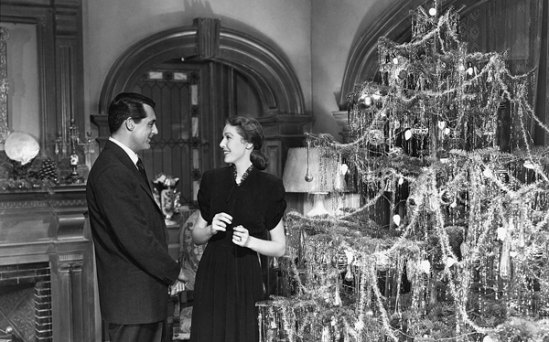
Samuel Goldwyn’s production The Bishop’s Wife (1947) is a lighthearted comedy about the spirit of Christmas. The film employs traditional Christian theology in a playful manner in order to advocate those principles that come with healing. The Bishop’s Wife was produced just two years after the close of WWII and it’s themes of closure, restoration and an exuberance for life spoke to those who had survived. Of course that’s all subtext. The Bishop’s Wife is, on the surface, a comedic vehicle for Cary Grant and Loretta Young.
Cary Grant plays Dudley, the angel sent from heaven in answer to Bishop Brougham’s (David Niven) prayers for guidance as he endeavors to enlist Mrs. Hamilton’s (Gladys Cooper) fortune in the construction of a new cathedral. To do this Dudley must force the Bishop to re-evaluate his priorities when it comes to his wife Julia (Loretta Young), his friend Professor Wutheridge (Monty Woolley) and above all else the purpose of his calling. Needless to say that plenty of yuletide hijinks ensue along the way before Dudley has restored things as they should be.
In establishing the nature and form of the angel Dudley The Bishop’s Wife is more than indebted to It’s A Wonderful Life (1946). But Dudley, unlike Clarence, teaches his lessons via example rather than through illusions. The dark chapter of It’s A Wonderful Life doesn’t exist in The Bishop’s Wife which, as an escapist spectacle, prefers the fantastic to the real world anxieties that plague George Bailey.
The Bishop’s Wife is as much Cary Grant’s film as It’s A Wonderful Life was James Stewart’s. Director Henry Koster seizes every opportunity to exploit Grant’s affable charms to the hilt. From the scene at the ice rink to the miraculous self-refilling bottle of sherry Cary Grant is afforded every chance to dazzle the viewer with his winning smile, his humor, and his patented charms.
The Bishop’s Wife is so invested in the figure of Cary Grant that the essential role that Loretta Young plays is almost entirely overshadowed. Young brings an earnestness to her character as well as a genuine desire to believe in the magic of Christmas. On a technical level she is the audience’s surrogate; the vessel through which our collective gaze is directed and filtered. When Loretta Young views Cary Grant with a romantic awe so do we.
With all of the studio lot sets, the fake snow, and the black and white photography (by the great Gregg Toland no less) films from the forties just feel like Christmas in a way other films do not. There’s a nostalgia for Christmas that is entirely formed by these films. Most people alive today weren’t around when films like The Bishop’s Wife were made and yet, as we inevitably look back, the Christmases we most as enjoyed as children take on the qualities of these Hollywood fantasias.
